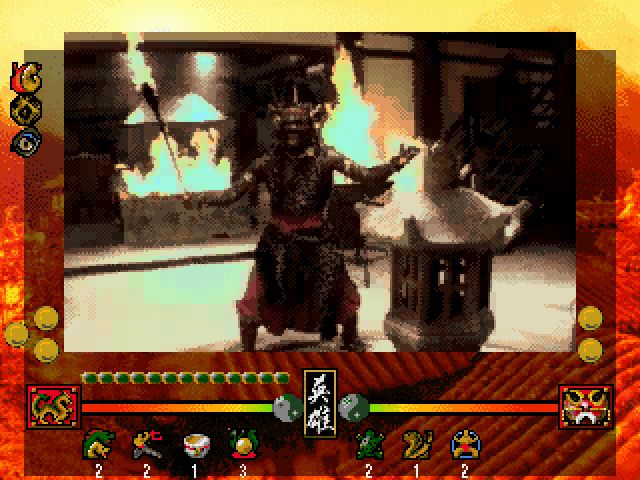Retro Replay Review
Gameplay
Supreme Warrior offers an interactive full-motion video (FMV) experience that blends movie sequences with on-screen prompts for punches, kicks, and blocks. Rather than free-roaming or combo-based fighting, the game relies on your timing: when a prompt appears, you must hit the correct button in rhythm with the action. Pull off the move at the right moment and you deal damage; miss it and you eat the blow. This quick-reaction gameplay keeps you on edge throughout each duel.
(HEY YOU!! We hope you enjoy! We try not to run ads. So basically, this is a very expensive hobby running this site. Please consider joining us for updates, forums, and more. Network w/ us to make some cash or friends while retro gaming, and you can win some free retro games for posting. Okay, carry on 👍)
The simplicity of the controls makes Supreme Warrior accessible even to players unfamiliar with traditional fighting mechanics. You won’t need to memorize lengthy combos or complex stick motions—just watch for visual cues and strike when prompted. However, this also means that depth and variety are somewhat limited. Beyond the basic punch, kick, and block choices, there’s little room for creative strategies or improvisation.
One notable feature is the pacing of the battles. Early fights against Wang Tu’s minions serve as a tutorial landmine, teaching you the rhythm of the prompts. As you progress, quick-cut edits in the live-action footage accelerate the tempo, forcing faster reactions. While this can be exhilarating, it also risks feeling repetitive over long play sessions. Players who thrive on lightning-fast reflexes will feel right at home, but those seeking a more sandbox-like fighting game may find the structure restrictive.
Graphics
Visually, Supreme Warrior leans into its FMV roots with digitized footage of martial artists filmed on set. The backgrounds feature ornate Chinese palaces and misty bamboo forests, lending the game an authentic period flavor. Costumes and props are elaborate, showcasing period-appropriate robes, weapons, and set dressing.
On the downside, the video quality reflects mid-’90s CD-ROM limitations: grainy textures, occasional compression artifacts, and frame rate drops. These hallmarks of the era give Supreme Warrior a distinct retro charm, but modern players accustomed to HD clarity may be taken aback by the visual fuzziness. Despite these technical constraints, the cinematography—complete with dynamic camera angles and choreographed fight sequences—helps maintain immersion.
Character animations appear smooth within the footage, but the transitions between video clips and interactive prompts can feel abrupt. When prompts flash on-screen, the action pauses momentarily, reminding you that you’re engaging with pre-recorded video rather than a fully rendered engine. Still, for fans of FMV titles, Supreme Warrior’s production values hold up surprisingly well and offer a nostalgic trip back to the dawn of interactive movie games.
Story
Set in ancient China, Supreme Warrior’s narrative revolves around the mystical Mask of Eternal Might, which, when whole, grants its bearer unimaginable power. You assume the role of a guardian charged with protecting one half of the mask from the nefarious warlord Wang Tu, who seeks to reunite both halves for evil purposes. This classic good-versus-evil premise drives you forward through a series of escalating confrontations.
Story beats are delivered via FMV cutscenes peppered between fights. Dialogue is concise and often delivered in stylized English accented by subtle echoes of traditional Chinese speech patterns. While not Shakespearean, the voice acting is earnest and adds personality to the protagonists and villains. Key plot moments—such as the reveal of Wang Tu’s master plan—play out like short martial-arts movie clips, complete with dramatic music swells.
Though the narrative is fairly straightforward, it benefits from clear stakes: if you fail, evil triumphs and the mask’s power is perverted. The simple storyline never overcomplicates itself, making it easy to follow even through multiple playthroughs. However, those craving deep character development or branching story branches may find the plot lean. Supreme Warrior’s story succeeds in motivating your next duel, but it stops short of delivering a truly epic saga.
Overall Experience
As a hallmark of early FMV gaming, Supreme Warrior occupies a unique niche. Its blend of live-action footage and interactive combat provides a novel experience in the mid-’90s era, one that stands apart from sprite-based or 3D polygon fighters. For players curious about gaming history or fans of martial-arts cinema, the title offers an engaging—and at times challenging—ride.
Replay value hinges largely on mastering the timing prompts and challenging yourself to perfect each sequence. There’s limited branching in terms of narrative or fight outcomes, so repetition is inevitable. However, attempting speed runs or one-hitting enemies can inject fresh motivation for seasoned players. Multiplayer modes—if available—add a competitive dimension, although they essentially boil down to who reacts faster to the same FMV cues.
Ultimately, Supreme Warrior is best approached as a nostalgia-driven interactive movie rather than a conventional fighting game. Its dated visuals and straightforward mechanics may not appeal to everyone, but where it shines is in its distinctive presentation and palpable sense of period atmosphere. If you’re intrigued by FMV titles or simply in search of a different spin on martial-arts action, Supreme Warrior deserves a spot in your retro gaming collection.
 Retro Replay Retro Replay gaming reviews, news, emulation, geek stuff and more!
Retro Replay Retro Replay gaming reviews, news, emulation, geek stuff and more!









Reviews
There are no reviews yet.